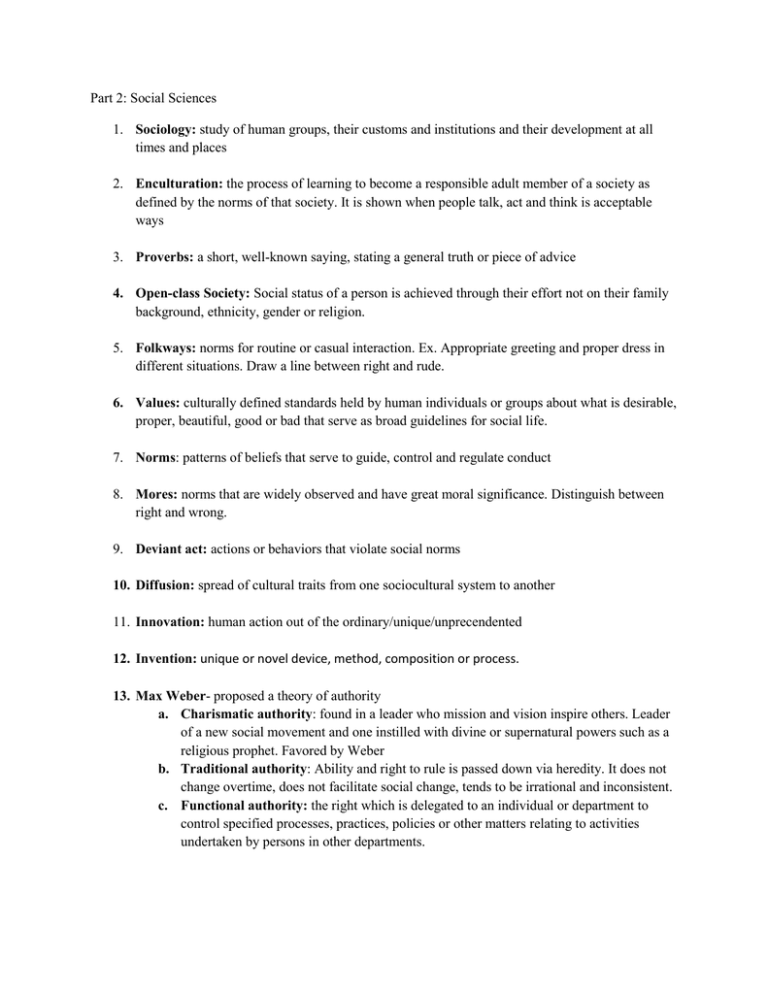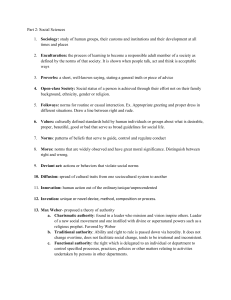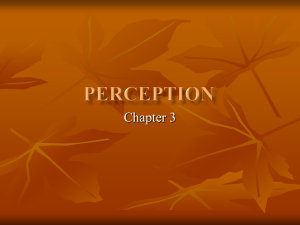Social Science - WordPress.com
advertisement

Part 2: Social Sciences 1. Sociology: study of human groups, their customs and institutions and their development at all times and places 2. Enculturation: the process of learning to become a responsible adult member of a society as defined by the norms of that society. It is shown when people talk, act and think is acceptable ways 3. Proverbs: a short, well-known saying, stating a general truth or piece of advice 4. Open-class Society: Social status of a person is achieved through their effort not on their family background, ethnicity, gender or religion. 5. Folkways: norms for routine or casual interaction. Ex. Appropriate greeting and proper dress in different situations. Draw a line between right and rude. 6. Values: culturally defined standards held by human individuals or groups about what is desirable, proper, beautiful, good or bad that serve as broad guidelines for social life. 7. Norms: patterns of beliefs that serve to guide, control and regulate conduct 8. Mores: norms that are widely observed and have great moral significance. Distinguish between right and wrong. 9. Deviant act: actions or behaviors that violate social norms 10. Diffusion: spread of cultural traits from one sociocultural system to another 11. Innovation: human action out of the ordinary/unique/unprecendented 12. Invention: unique or novel device, method, composition or process. 13. Max Weber- proposed a theory of authority a. Charismatic authority: found in a leader who mission and vision inspire others. Leader of a new social movement and one instilled with divine or supernatural powers such as a religious prophet. Favored by Weber b. Traditional authority: Ability and right to rule is passed down via heredity. It does not change overtime, does not facilitate social change, tends to be irrational and inconsistent. c. Functional authority: the right which is delegated to an individual or department to control specified processes, practices, policies or other matters relating to activities undertaken by persons in other departments. d. Legal authority: fosters belief in competence of the individual discharging statutory obligation 14. Endogenous: having internal cause of origin 15. Marxist’s Model: socio-economic and political worldview or inquiry based on a materialist interpretation of historical development a dialectical view of social transformation, an analysis of class-relations and conflict within society. a. Major criticism: overemphasis on importance of economic class to explain historical trends 16. Sanction: A reward for conformity or a punishment for nonconformity that reinforces socially approved forms of behavior 17. Institution: any structure of mechanism of social order and cooperation governing the behavior of a set of individuals within a given community 18. Kinship: The network of social relationships which link individuals through common ancestry, marriage or adoption. 19. Subculture: A group within the broader society that has values, norms and lifestyle distinct from those of the majority 20. Community: A group of people who share a common sense of identity and interact with one another on a sustained basis 21. Pepinsky: effective form of social control among Chinese communists is by group manipulation of guilt and shame. 22. Bureaucracy: A formal organization marked by a clear hierarchy of authority, the existence of written rules of procedure, staffed by full-time salaried officials, and striving for the efficient attainment of organizational goals. 23. Primary function of religion in human societies: establish orderly relationship between man and surroundings 24. Primary groups: small social group whose members share close, personal, enduring relationships. 25. Secondary groups: interact on a less personal level than primary, and relationships are temporary rather than long lasting. Established to perform functions and people’s roles are interchangeable. 26. Fascist system: form of radial authoritarian nationalism. Unify nation through totalitarian state that promoted mass mobilization of national community. View political violence, war and imperialism as means to achieve national rejuvenation and asserts that stronger nations have the right to expand their territory by displacing weaker nations. 27. Caste System vs Class System a. Caste system: form of social stratification characterized by hereditary transmission of style of life which often includes an occupation, ritual status in hierarchy and customary social interaction and exclusion based on cultural notions of purity and pollution. b. Class system: people are grouped into a set of hierarchical social categories, the most common being upper, middle and lower classes. 28. Stereotypes: A rigid and inflexible image of the characteristics a group. a. People initially interact with them rather than a true person 29. Discovery: initial awareness of existing but unobserved elements of nature 30. Clairvoyance: ability to gain information about an object, person, location or physical event through means other than the known human senses. 31. Psychokinesis: supposed ability to move objects by mental effort alone 32. Precognition: foreknowledge of an event especially as a form of extrasensory perception 33. Telepathy: supposed communication of thoughts or ideas by means other than the known senses 34. Fixation: concept originating from Sigmund Freud. It is the state in which becomes obsessed with an attachment to another person, being or object. 35. Identification: psychological process whereby the subject assimilates an aspect, property or attribute of the other and is transformed, wholly or partially after the model the other provides. 36. Repression: to repel one’s own desires and impulses towards pleasurable instincts by excluding the desire form one’s consciousness and holding or subduing it in the unconscious. 37. Regression: defense mechanism leading to temporary or long-term reversion of the ego to an earlier stage of development rather than handling unacceptable impulses in a more adult way. 38. Illusion: distortion of the senses, revealing how the brain normally organizes and interprets sensory stimulation. 39. Hallucination: perception in the absence of apparent stimulus which has qualities of real perception. 40. Auditory imagery: form of mental imagery that is used to organize and analyze sounds when there is no external auditory stimulus present 41. Eidetic imagery: The Eidetic Image has been identified in psychological literature as a vision, as a source for new thought and feeling, as a material picture in the mind which can be scanned by the person as he would scan a real current event in his environment. 42. Affective disorder/Mood disorder: psychological disorder characterized by elevation or lowering of a person’s mood, such as depression or bipolar disorder. 43. Panic reaction: an acute overwhelming attack of fear or anxiety producing personality disorganization that may persist 44. Generalized anxiety: an anxiety disorder characterized by chronic free-floating anxiety and such symptoms as tension or sweating or trembling or lightheadedness or irritability etc that has lasted for more than six months 45. Schizophrenia: a long-term mental disorder of a type involving a breakdown in the relation between thought, emotion, and behaviour, leading to faulty perception, inappropriate actions and feelings, withdrawal from reality and personal relationships into fantasy and delusion, and a sense of mental fragmentation. 46. Dopamine: neurotransmitter- chemical released by nerve cells to send signals to other nerve cells. 47. Enkephalin: involved in regulating nociception (pain) in the body. 48. Epinephrine: many functions in body, regulating heart rate, blood vessel and air passage diameters. Crucial part of fight or flight response. 49. Thorazine/Chlorpromazine: synthetic drug used as a tranquillizer or sedative 50. Percept: an object of perception; something that is perceived 51. Subliminal: below the threshold of sensation or consciousness 52. Threshold: magnitude or intensity that must be exceeded for a certain reaction 53. Piaget’s stages of cognitive growth a. Sensorimotor: birth through 18-24 months- only aware what is immediately in front of them. They focus on what they see, what they are doing and physical interactions with their immediate environment b. Preoperational: Toddlerhood to childhood (7)- Think about things symbolically. Their language becomes more mature and develop memory and imagination which allows them to understand the difference between past and future. c. Operational: ages 7-12- demonstrate logical and concrete reasoning. Thinking becomes less egocentric and increasingly aware of external events. d. Formal operational: adolescence through adulthood- able to logically use symbols related to abstract concepts 54. Von Restorff effect: aka isolation effect, predicts that an item that “stands out like a sore thumb” is more likely to be remembered than other items. 55. Zeigarnik effect: people remember uncompleted or interrupted tasks better than completed tasks 56. Greenspoon effect: experimental effect found in some studies of verbal conditioning in which the speaker’s use of certain classes of words may increase in frequency when reinforced by the listener making appropriate diffident gestures of assent. 57. Muller-Lyer illusion: optical illusion consisting of stylized arrow. 58. Gestalt Principle of perceptual organization: brain is holistic, parallel and analog with selforganizing tendencies. a. Proximity: objects or events that are near to one another are perceived as belonging together as a unit b. Continuation: there is innate tendency to perceive a line as continuing its established direction c. Closure: innate tendency to perceive incomplete objects as complete and to close or fill gaps and to perceive asymmetric stimuli as symmetric d. Common fate law: aspects of perceptual field that move or function in a similar manner will be perceived as a unit e. Similarity law: parts of a stimulus field that are similar to each other tend to be perceived as belonging as a unity 59. Loving parent who is firm and consistent produces a competent and self-reliant child. 60. Man’s impulses most frequently conflict with moral standards of society: sex and aggression 61. Selective attention: being able to focus one’s auditory attention on a particular stimulus while filtering out a range of other stimuli 62. Sensory adaptation: change over time in the responsiveness of sensory system to a constant stimulus 63. Just noticeable difference: Smallest detectable difference between a starting and secondary level of particular sensory stimulus 64. Roger’s Self Theory: Roger’s rejected the deterministic nature of psychoanalysis and behaviorism and maintained that we behave as we do because of the way we perceive our situation. Believed that humans have one basic motive, that is the tendency to self-actualize- to fulfill one’s potential and achieve the highest level of human-beingness we can. 65. Negative transfer: the obstruction of or interference with new learning because of previous learning. 66. Spontaneous recovery: phenomenon of learning and memory which was first seen in classical conditioning and refers to a re-emergence of a previously extinguished conditioned response after a delay. 67. Operant conditioning: conditioning in which an operant response is brought under stimulus control by virtue of presenting reinforcement contingent upon the occurrence of the operant response. 68. Stimulus generalization: transfer of a response learned to one stimulus to a similar stimulus 69. Phobias: an extreme or irrational fear of or aversion to something 70. Classical conditioning: learning process that occurs when two stimuli are repeatedly paired: a response which is first elicited by the second stimulus is eventually elicited by the first stimulus alone 71. Desensitization: process of reducing sensitivity 72. Modeling: for of learning where individuals ascertain how to act or perform by observing another individual 73. Diffusion of responsibility: sociopsychological phenomemnon whereby a person is less likely to take responsibility for action or inaction when others are present (e.g. being in a public place). 74. Problem with experimental research in psychology: Demand characteristics, hawthorne effect and halo effect. 75. Demand characteristics: experimental artifact where participants form an interpretation of the experiment’s purpose and unconsciously change their behavior to fit that interpretation. 76. Hawthorne effect: the alternation of behavior by the subjects of a study due to their awareness of being observed 77. Halo effect: tendency for an impression created in one area to influence opinion in another area 78. Random assignment: experimental technique for assigning subjects to different treatments. 79. Heuristic availability: mental shortcut that relies on immediate examples that comes to mind. 80. Gestalt therapy: psychotherapeutic approach that focuses on insight into gestalts in patients and their relations to the world, and often uses role playing to aid the resolution of past conflicts. 81. Reality therapy: approach to psychotherapy and counseling. Focuses on realism, responsibility and right-and-wrong, rather than symptoms of mental disorders. 82. Psychoanalysis: system of psychological theory and therapy which aims to treat mental disorders by investigating the interaction of conscious and unconscious elements in the mind and bringing repressed fears and conflicts into the conscious mind by techniques such as dream interpretation and free association. 83. Behavior therapy: the treatment of neurotic symptoms by training the patient’s reactions to stimuli 84. Client-centered therapy: developed by Carl Rogers in which the client determines the focus and pace of each session. 85. Rational emotive therapy: comprehensive, active-directive, philosophically and empirically based psychotherapy which focuses on resolving emotional and behavioral problems and disturbances and enabling people to lead happier and fulfilling lives. 86. Contrast: to set in opposition in order to show or emphasize differences. 87. Habituation: decrease in response to a stimulus after repeated presentations 88. Repetition: act or process or an instance of repeating or being repeated 89. Projection: defense mechanism in which a person unconsciously rejects his or her own unacceptable attributes by ascribing them to objects or persons in the outside world 90. Suppression: “conscious” exclusion of painful memories, thoughts etc. 91. Sigmund Freud: father of psychoanalysis 92. Maslow’s Hierarchy of needs: theory of human motivation. Bottom of triangle is the more basic needs. a. At the bottom of the triangle is physiological- breathing, food, water, sex, sleep, homeostasis and excretion. b. Safety- security of body, employment, resources, morality, family, health and property. c. Love/belonging- friendship, family, sexual intimacy d. Esteem- self-esteem, confidence, achievement, respect of others and respect by others e. Self-actualization- morality, creativity, spontaneity, problem solving, lack of prejudice and acceptance of facts







